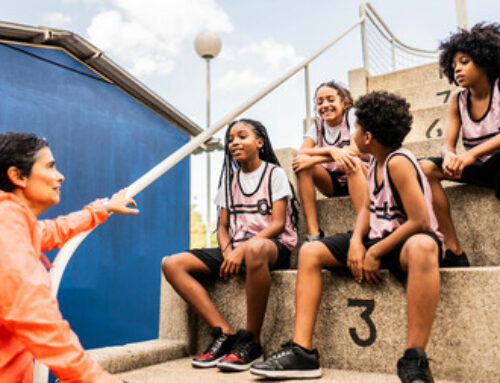Youth Speed Drills You Need to Know
Working with youth athletes to improve their speed is both rewarding and challenging. Speed workouts come in many forms, and from working with youth athletes of all sports and all ages, I have noticed a few common threads regarding acceleration and top-speed mechanics.
- Young athletes often don’t possess the strength and postural awareness to properly produce ground reaction force.
- A speed workout for youth athletes must be short, concise and broken down into small, attainable pieces.
- Reward, reward, reward, then try to fix just one piece of the puzzle on every speed drill.
- Have fun.
Based on these four points, I have put together my favorite youth speed drills that teach acceleration and absolute speed.
Youth Speed Drills
Medicine Ball Overhead A-Skip
This is a variation of a classic A-Skip meant to teach postural integrity. The med ball should be light. This is not an exercise to strengthen the athlete’s legs. Holding the medicine ball overhead simply puts the athlete in a more extended position, allowing him or her to work on proper posture. This is a great tool for athletes who collapse at the hip and fold forward while skipping and running.
Coaching Points: Stay tall, have a big reach, knees up, toes up, keep a book on your head.
Absolute Speed Standing Wall Drill With Hold
This is a great drill to work on minimizing backside mechanics at top speed. As the athlete claws the ground beneath his or her body, he or she works to keep heel recovery to a minimum, then drives the knee and ankle back to the start position. Add a posture hold at the top to drive home the start and finish position on each stride.
Coaching Points: Claw and pop, strike slightly out in front of the down leg, and pull. The movement should be like quickly striking a match. Maintain perfect posture.
Dead-Leg Hurdle Drill
This is a great speed drill to teach stiffness, posture and knee drive. The posting leg should remain stiff with the ankle dorsiflexed. This will teach a good snap and pop off the dead leg while the action leg is teaching the knee drive and recovery. Focus on posture, snap and pop, and don’t forget aggressive arm action.
Coaching Points: Stay tall, pop and punch, arms go from cheek to cheek.
Alternating Cyclic Run
This speed drill emphasizes striking the ground and recovery for top-speed mechanics. The drill also challenges coordination. The athlete goes into a top-speed cyclic step every third step.
Coaching Points: Be stiff and snappy, arms go from cheek to cheek, the drive phase should be quick.
These drills start teaching mechanics. However, without strength and the ability to create and absorb force, mechanics won’t matter much. I have included two videos of strength exercises I like to use for my track athletes. Not all youth athletes are at this level, and before my athletes get into these movements, they must first master Bodyweight Squats, Lunges, Lateral Lunges and hinging patterns. The key is to progress your athletes steadily and safely.
RELATED: Jumping to New Performance Levels: Plyometric Training for Youth Athletes
RECOMMENDED FOR YOU
MOST POPULAR
Youth Speed Drills You Need to Know
Working with youth athletes to improve their speed is both rewarding and challenging. Speed workouts come in many forms, and from working with youth athletes of all sports and all ages, I have noticed a few common threads regarding acceleration and top-speed mechanics.
- Young athletes often don’t possess the strength and postural awareness to properly produce ground reaction force.
- A speed workout for youth athletes must be short, concise and broken down into small, attainable pieces.
- Reward, reward, reward, then try to fix just one piece of the puzzle on every speed drill.
- Have fun.
Based on these four points, I have put together my favorite youth speed drills that teach acceleration and absolute speed.
Youth Speed Drills
Medicine Ball Overhead A-Skip
This is a variation of a classic A-Skip meant to teach postural integrity. The med ball should be light. This is not an exercise to strengthen the athlete’s legs. Holding the medicine ball overhead simply puts the athlete in a more extended position, allowing him or her to work on proper posture. This is a great tool for athletes who collapse at the hip and fold forward while skipping and running.
Coaching Points: Stay tall, have a big reach, knees up, toes up, keep a book on your head.
Absolute Speed Standing Wall Drill With Hold
This is a great drill to work on minimizing backside mechanics at top speed. As the athlete claws the ground beneath his or her body, he or she works to keep heel recovery to a minimum, then drives the knee and ankle back to the start position. Add a posture hold at the top to drive home the start and finish position on each stride.
Coaching Points: Claw and pop, strike slightly out in front of the down leg, and pull. The movement should be like quickly striking a match. Maintain perfect posture.
Dead-Leg Hurdle Drill
This is a great speed drill to teach stiffness, posture and knee drive. The posting leg should remain stiff with the ankle dorsiflexed. This will teach a good snap and pop off the dead leg while the action leg is teaching the knee drive and recovery. Focus on posture, snap and pop, and don’t forget aggressive arm action.
Coaching Points: Stay tall, pop and punch, arms go from cheek to cheek.
Alternating Cyclic Run
This speed drill emphasizes striking the ground and recovery for top-speed mechanics. The drill also challenges coordination. The athlete goes into a top-speed cyclic step every third step.
Coaching Points: Be stiff and snappy, arms go from cheek to cheek, the drive phase should be quick.
These drills start teaching mechanics. However, without strength and the ability to create and absorb force, mechanics won’t matter much. I have included two videos of strength exercises I like to use for my track athletes. Not all youth athletes are at this level, and before my athletes get into these movements, they must first master Bodyweight Squats, Lunges, Lateral Lunges and hinging patterns. The key is to progress your athletes steadily and safely.
RELATED: Jumping to New Performance Levels: Plyometric Training for Youth Athletes












